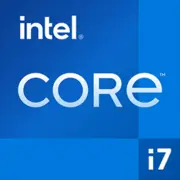Intel Core i7-12800H

Intel Core i7-12800H: Power and Balance for Mobile Tasks
March 2025
Architecture and Fabrication Process: The Hybrid Evolution of Alder Lake
The Intel Core i7-12800H processor, released in 2022, is part of the revolutionary Alder Lake generation that has transformed mobile performance. Its architecture features 6 high-performance P-cores (Performance-cores) and 8 energy-efficient E-cores (Efficient-cores), totaling 14 cores and 20 threads. The P-cores operate at a base frequency of 2.4 GHz, boosting to 4.8 GHz in turbo mode, while the E-cores reach up to 3.7 GHz. This hybrid approach allows for optimal task distribution: P-cores handle heavy applications, while E-cores manage background processes.
The Intel 7 fabrication process (formerly known as 10nm Enhanced SuperFin) offers high transistor density and energy efficiency. The integrated graphics Intel Iris Xe with 96 Execution Units (EUs) supports 4K displays, hardware video acceleration, and moderate gaming performance. For instance, in Dota 2 at medium settings, users can expect around 50-60 FPS.
Power Consumption and TDP: Managing Power
The nominal TDP of the processor is 45 W, but under turbo mode, consumption can reach 95 W, typical for high-performance mobile CPUs. However, Intel has implemented advanced power management algorithms:
- Intel Dynamic Tuning 2.0 — automatically adjusts power based on workload and temperature.
- Thread Director — optimizes task distribution between P- and E-cores, reducing energy costs.
In office scenarios (like working in Excel + browsing), the processor can drop consumption to 15-20 W by switching to the E-cores. However, in gaming or rendering, the laptop cooling system must handle brief spikes up to 100 W.
Performance: Real Tasks and Turbo Mode
Tests conducted with Geekbench 6 reveal results of 2246 in Single-Core and 11096 in Multi-Core, placing the i7-12800H among the top mobile processors of 2022-2023. Practically, this translates to:
- Office Work: Running 50+ tabs in Chrome, concurrent work in Photoshop, and video conferencing — without lag.
- Multimedia: Rendering 4K video in Premiere Pro takes about 20-25 minutes (for a 10-minute project).
- Gaming: In conjunction with a discrete GPU (like the RTX 3060) — stable 60+ FPS in Cyberpunk 2077 at high settings (without ray tracing).
Turbo mode demonstrates impressive performance, but its duration depends on the cooling system. In ultrabooks (e.g., ASUS ZenBook Pro 15), peak frequencies are maintained for 10-15 seconds before the CPU throttles. In gaming laptops (MSI GP66), it can last up to 30 minutes.
Usage Scenarios: Who is the i7-12800H Suitable For?
1. Professionals: Video editors, 3D designers, engineers (using SolidWorks, AutoCAD).
2. Gamers: For gaming in Full HD/1440p with a discrete graphics card.
3. Universal Users: Those seeking a powerful laptop for work and entertainment.
Example: The Dell XPS 17 with the i7-12800H excels at rendering 3D models and streaming simultaneously.
Battery Life: Balancing Power and Runtime
Under moderate load (watching YouTube, office tasks), laptops with this CPU achieve 6-8 hours of runtime (with an 80-90 Wh battery). In maximum performance mode, this drops to no more than 1.5-2 hours.
Energy-saving technologies:
- Adaptix™ — dynamic shutdown of unused cores.
- Deep Learning Boost — optimizing AI tasks with lower energy consumption.
Tip: To extend battery life, disable turbo mode in Windows settings (“Power Options” → “Ultimate Performance” → “Disable”).
Comparison with Competitors: Who Stands Out?
- AMD Ryzen 9 6900HX: Better for multi-threaded tasks (like rendering), but weaker in single-threaded performance (gaming).
- Apple M2 Pro: Higher battery life on the MacBook Pro (up to 12 hours), but Windows software compatibility is limited.
- Intel Core i9-12900H: Only 5-10% faster but is more expensive and runs hotter.
Prices for laptops with the i7-12800H in 2025:
- Budget models (Acer Nitro 5) — starting from $900.
- Premium models (Razer Blade 15) — up to $2000.
Pros and Cons
Strengths:
- High performance in both single-threaded and multi-threaded tasks.
- Support for PCIe 5.0 and DDR5 for future upgrades.
- Versatility (gaming, work, creativity).
Weaknesses:
- Heat generation under load (requires high-quality cooling).
- Battery life lags behind Apple Silicon.
Recommendations for Laptop Selection
1. Gaming Laptop (like Lenovo Legion 5 Pro):
- Must include discrete GPU (RTX 3060 and above).
- Cooling system with 4+ heat pipes.
2. Workstation (HP ZBook Fury 16):
- Screen coverage of 100% sRGB.
- 32+ GB DDR5 RAM.
3. Ultrabook (MSI Prestige 14):
- Weighs up to 1.5 kg.
- Battery of 70 Wh or more.
Final Conclusion
The Intel Core i7-12800H is an ideal choice for those looking for a versatile laptop without compromises. It is suitable for:
- Engineering students.
- Gamers who are not ready to invest in a PC.
- Freelancers working with "heavy" software.
Its key advantages include performance, support for modern standards, and flexibility. However, if battery life is more important than performance for you — consider the Apple M2/M3 or AMD Ryzen 7000 series.
Basic
CPU Specifications
Memory Specifications
GPU Specifications
Miscellaneous
Benchmarks
Compared to Other CPU
Share in social media
Or Link To Us
<a href="https://cputronic.com/cpu/intel-core-i7-12800h" target="_blank">Intel Core i7-12800H</a>